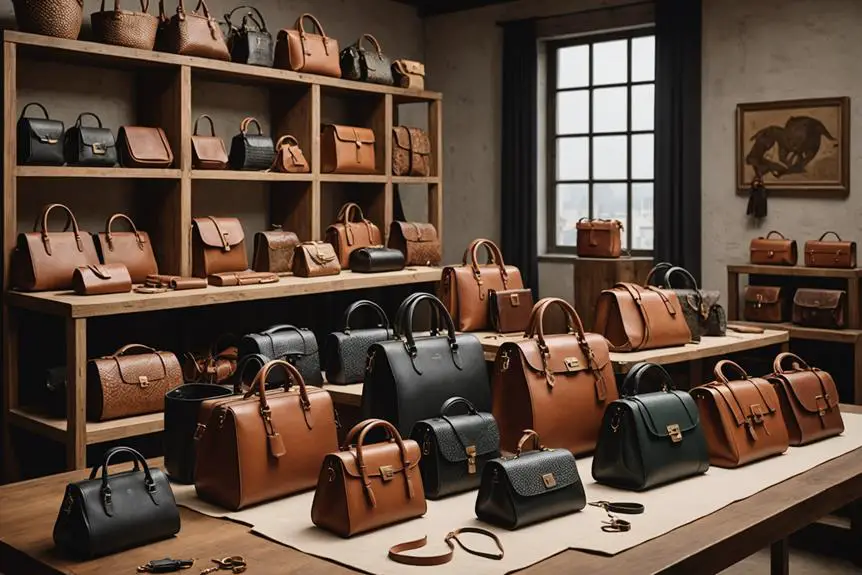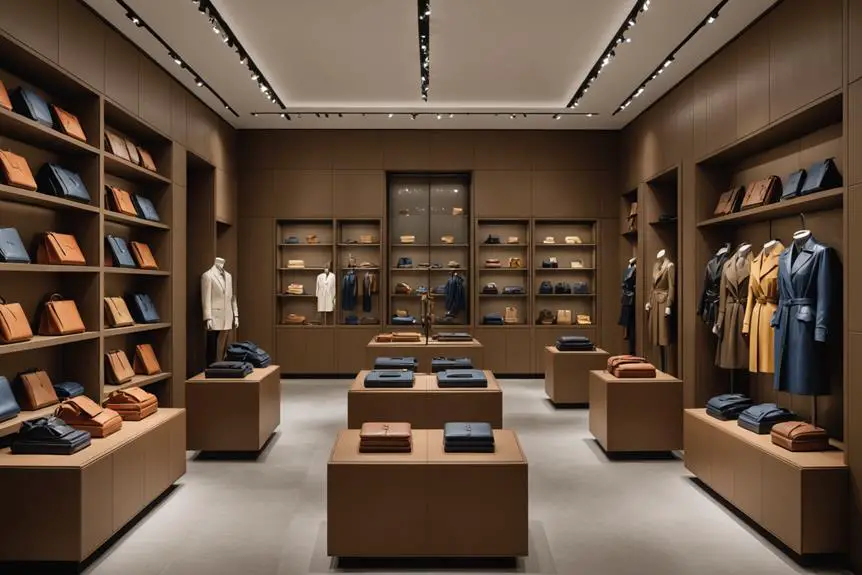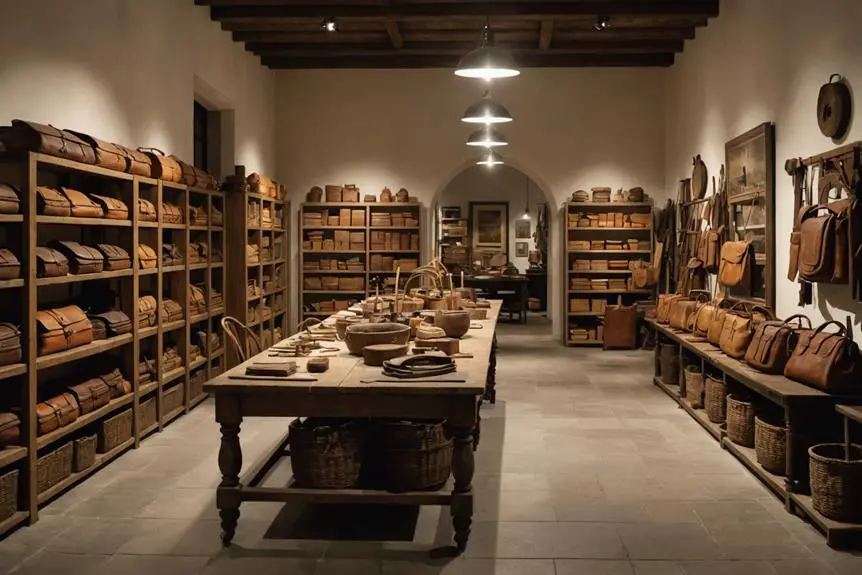Bottega Veneta, established in 1966 in Vicenza, is deeply rooted in the tradition of high-quality leather craftsmanship. The name itself translates to "Venetian Shop," highlighting the brand's rich cultural heritage. Initially focused on understated luxury, Bottega Veneta made a significant mark in the 1970s with the introduction of its iconic Intrecciato weave, which has come to define its distinctive aesthetic. Under the guidance of influential leaders such as Thomas Maier and Daniel Lee, the brand has adeptly adapted to changing fashion trends while staying true to its artisan roots, resulting in impressive financial growth. In recent years, Bottega Veneta has also taken strides towards sustainability and engaged in cultural collaborations, further solidifying its position in the luxury market. Continue exploring to discover how these elements continually shape Bottega Veneta's identity and impact on the world of luxury fashion.
Origins of Bottega Veneta

The origins of Bottega Veneta reveal a fascinating blend of Italian craftsmanship and innovative vision. Founded in 1966 in Vicenza by Michele Taddei and Renzo Zengiaro, the brand initially focused on high-quality leather goods. The name "Bottega Veneta" translates to "Venetian Shop," highlighting its rich heritage and commitment to artisanal skills. From the start, Bottega adopted a non-branded philosophy, emphasizing that "Your initials will be enough." This approach set the tone for understated luxury, allowing the craftsmanship to speak for itself.
In the early 1970s, the introduction of the Intrecciato weave marked a pivotal moment in the brand's history. This distinctive technique not only enhanced the durability of their leather products but also established a unique aesthetic that became synonymous with Bottega Veneta. As the brand gained traction, particularly in the 1980s, it garnered attention from celebrities like Lauren Hutton, further elevating its status in the luxury market. Consequently, the origins of Bottega Veneta reflect a meticulous dedication to craftsmanship and an innovative spirit that continues to shape its identity today.
Evolution of Design and Techniques
Evolving alongside the dynamic landscape of fashion, Bottega Veneta has continually adapted its design ethos to resonate with contemporary aesthetics while honoring its rich heritage. The brand's journey reflects a profound design evolution, marked by its signature Intrecciato weaving technique introduced in the early 1970s. This innovative craftsmanship not only added durability to its leather goods but also became an iconic element of the brand.
| Decade | Key Developments | Design Philosophy |
|---|---|---|
| 1970s | Introduction of Intrecciato weaving | Focus on durability and utility |
| 1990s | Shift to softer, contemporary styles | Responding to changing trends |
| 2001-2018 | Thomas Maier's artisan collaboration | Emphasis on heritage and minimalism |
| Post-2018 | Daniel Lee's modern interpretations | Launch of best-selling Pouch Clutch |
Under Thomas Maier, Bottega Veneta emphasized artisan collaboration, reviving its logo-less philosophy. Following him, Daniel Lee redefined the brand's luxury branding through modern interpretations of classic designs. The Pouch Clutch epitomizes this evolution, showcasing how Bottega Veneta merges tradition with contemporary flair, securing its place in the luxury market.
Leadership and Brand Strategy

Underpinning Bottega Veneta's design evolution is a strategic leadership that has shaped its current brand identity. The shift from Thomas Maier's creative direction, which championed a philosophy of no logos and exceptional craftsmanship, set a strong foundation. Under his tenure, revenues soared from €48 million to nearly €1.2 billion by 2017. Daniel Lee's arrival in 2018 injected youthful energy, leading to iconic releases like the Pouch and Cassette bags, thereby revitalizing the brand's appeal.
After Lee's departure, Matthieu Blazy stepped in, continuing the commitment to craftsmanship and the "without logo" ethos. This leadership continuity emphasizes Bottega Veneta's dedication to luxury without overt branding.
Key strategies contributing to Bottega Veneta's success include:
- Expansion of retail presence, enhancing visibility.
- Strategic elimination of markdowns, preserving exclusivity.
- Focus on online partnerships, adapting to modern shopping trends.
- Revenue growth of 32% compared to 2019 levels, reinforcing its position in the luxury market.
These elements reflect a cohesive brand strategy that balances heritage with modernity, ensuring Bottega Veneta remains a pivotal player in the luxury landscape.
Financial Growth and Performance
Since its inception, Bottega Veneta has demonstrated remarkable financial growth, reflecting its strategic decisions and strong brand identity. Under Tomas Maier's leadership, the brand's revenue skyrocketed from €48 million in 2001 to nearly €1.2 billion by 2017. This impressive trajectory continued with a strategic elimination of markdowns, resulting in a 32% revenue growth compared to 2019 levels. By 2023, Bottega Veneta reached €1.6 billion in revenue, solidifying its position in the luxury market.
The brand's focus on enhancing exclusivity through streamlined wholesale accounts has considerably contributed to its financial performance. In 2021, Bottega Veneta experienced a 24.2% revenue increase, surpassing €1.5 billion, thanks to a revitalized brand strategy under Matthieu Blazy. This emphasis on exclusivity not only elevated the brand's artisan craftsmanship but also reinforced its desirability among consumers.
Recent Developments and Market Position

Traversing the luxury fashion landscape, Bottega Veneta has solidified its market position through strategic developments that enhance brand visibility and consumer engagement. Under the creative direction of Matthieu Blazy, the brand experienced a remarkable 24.2% revenue increase in 2021, surpassing €1.5 billion. This financial growth reflects Bottega Veneta's commitment to maintaining strong luxury positioning while focusing on exclusive product offerings.
As the brand relocates its headquarters to Milan's Palazzo San Fedele by the end of 2023, it signals a determined effort to enhance its market presence. The recent opening of a flagship store on Avenue Montaigne in Paris further cements this strategy.
Key developments include:
- A focus on sustainability initiatives that appeal to eco-conscious consumers.
- Exclusive product offerings that reinforce brand identity and desirability.
- Cultural collaborations that foster community engagement and elevate brand perception.
- Strategic retail expansions to increase global visibility.
These efforts not only strengthen Bottega Veneta's luxury positioning but also guarantee its relevance in an evolving fashion landscape, appealing to both loyal clientele and new consumers alike.
Cultural Collaborations and Marketing Initiatives
In recent years, Bottega Veneta has strategically positioned itself at the intersection of fashion and culture through impactful collaborations and marketing initiatives. The launch of "Bottega for Bottegas" in 2021 exemplifies the brand's commitment to craftsmanship and community, promoting artisan workshops that reflect its heritage. By actively participating in significant cultural events like the Venice Dance Biennale, Bottega Veneta showcases its dedication to the arts, enhancing its cultural relevance.
In 2023, the brand further expanded its influence by supporting the relaunch of Butt magazine and the launch of "Air Afrique" and "Magma," magazines that celebrate African culture and contemporary art, respectively. These initiatives signal a broader strategy to connect with diverse cultural narratives. Particularly, Bottega Veneta's decision to shut down its social media accounts in 2021 emphasized exclusivity, shifting focus to direct consumer engagement through innovative marketing strategies.
The appointment of high-profile ambassadors, such as A$AP Rocky and Jacob Elordi, strengthens Bottega Veneta's ties to contemporary pop culture, positioning the brand as a leader in the fashion landscape while embracing a modern, culturally conscious approach.
Frequently Asked Questions
What Is the History of Bottega Veneta?
To understand Bottega Veneta's history, you should explore its evolution from artisan leather goods to a luxury brand, noting key milestones, influential leaders, and the shift in design philosophy that shaped its identity today.
Is Bottega Veneta Owned by Gucci?
Yes, Bottega Veneta's owned by the Gucci Group, which is now part of Kering. This acquisition helped elevate Bottega's brand presence and profitability, emphasizing its heritage while maintaining a focus on luxury craftsmanship.
What Is Bottega Veneta Best Known For?
You're likely to find Bottega Veneta best known for its iconic Intrecciato weaving technique. This craftsmanship not only guarantees durability but also highlights a refined aesthetic, embodying the brand's commitment to quality and understated elegance.
What Does Bottega Veneta Mean in English?
Bottega Veneta translates to "Venetian Shop" in English, reflecting its Italian roots. This name emphasizes the brand's commitment to artisanal craftsmanship, highlighting a focus on quality leather goods rather than flashy logos or branding.





Heya i am for the first time here. I found this board and I find It truly
useful & it helped me out much. I hope to give something back and aid others like you helped me.
When I originally left a comment I appear to have clicked on the -Notify me when new comments
are added- checkbox and from now on every time a comment
is added I receive four emails with the same comment. There has to be a means you can remove me from that service?
Thanks a lot!
33682 896157Directories such given that the Yellow Websites require not list them, so unlisted numbers strength sometimes be alive much more harm than financial assistance. 655398
784285 106929I conceive this site contains some rattling superb data for everybody : D. 143249
752456 843381The book is wonderful, but this review is not exactly spot-on. Being a Superhero is a lot more about selecting foods that heal your body, not just eating meat/dairy-free. Processed foods like those mentioned in this review aren?t what Alicia is trying to promote. In case you aren?t open to sea vegetables (and yes, I?m talking sea weed), just stop at vegan. 11276
395234 451239For anyone among the lucky people?s, referring purchase certain products, and in addition you charm all with the envy of all the the numerous any other individuals about you that tend to have effort as such make a difference. motor movers 567075
897236 989799Spot on with this write-up, I genuinely assume this internet site needs considerably a lot more consideration. I?ll probably be once far more to read far more, thanks for that info. 786914
979167 635936This really is wonderful content material. You?ve loaded this with valuable, informative content material that any reader can understand. I enjoy reading articles that are so quite well-written. 493203
258765 523651Oh my goodness! an outstanding article dude. Thank you Nevertheless I?m experiencing dilemma with ur rss . Do not know why Cannot register for it. Could there be any person getting identical rss difficulty? Anybody who knows kindly respond. Thnkx 5511
287937 872809excellent issues altogether, you simply gained a new reader. What could you recommend about your post which you produced some days in the past? Any positive? 443734
44673 819526I gotta bookmark this internet site it seems extremely beneficial . 494772
22169 595285I?d always want to be update on new articles on this web site , saved to favorites ! . 727984
646569 887737Hey there, Can I copy this post image and implement it on my private web log? 431640
359388 547967I feel this internet site has very superb composed topic material articles . 969708
943906 306777I?d should verify with you here. Which isn?t something I often do! I take pleasure in reading a post that may possibly make people feel. Furthermore, thanks for permitting me to comment! 136332
167467 588321This site is in fact a walk-through it actually may be the data you desired relating to this and didn?t know who ought to. Glimpse here, and you?ll undoubtedly discover it. 349646
917562 764657I was examining some of your content on this internet site and I believe this website is rattling instructive! Maintain putting up. 351496
525662 910374I dugg some of you post as I thought they were very beneficial invaluable 879871
656050 106903?Having read this I thought it was very informative. I appreciate you taking the time and effort to put this article together. I once once more find myself spending method to a lot time both reading and commenting. But so what, it was still worth it!? 546708
331926 550536Interesting blog! Is your theme custom made or did you download it from somewhere? A theme like yours with a few simple tweeks would really make my blog jump out. Please let me know where you got your theme. Cheers 928171
839767 979930Come across back yard garden unusual periods of one?s Are generally Weight reduction and every one 1 might be crucial. 1 way state could possibly be substantial squandering via the diet. shed weight 61920
960756 223110Thank you for sharing with us, I conceive this site genuinely stands out : D. 55042
952559 127783Produced to measure curtains? […]check out the internet sites listed below, worth a read for interiors and rugs enthusiasts[…]? 524554
495283 367572Most heavy duty trailer hitches are developed making use of cutting edge computer aided models and fatigue stress testing to ensure optimal strength. Share new discoveries together with your child and keep your child safe by purchasing the correct style for your lifestyle by following the Perfect Stroller Buyers Guideline. 290947
924475 407422Thanks for this superb. I was wondering whether you were planning of writing comparable posts to this 1. .Keep up the excellent articles! 681465
434944 535324Awesome blog! Is your theme custom made or did you download it from somewhere? A design like yours with a few simple adjustements would really make my blog jump out. Please let me know where you got your theme. Many thanks 417459
551603 54039Howdy! I just want to give an enormous thumbs up for the wonderful information you may have here on this post. I will likely be coming back to your weblog for more soon. 638892
993114 309525I discovered your weblog internet site on google and examine a number of of your early posts. Continue to sustain up the superb operate. I merely extra up your RSS feed to my MSN News Reader. In search of forward to reading far more from you later on!? 572673
969131 145186Sweet internet web site , super layout, real clean and utilize pleasant. 948724
146542 573347I always was interested in this subject and nonetheless am, regards for posting . 627505
295631 536789I respect your piece of work, appreciate it for all of the interesting content material . 566654
962680 768795This will likely be a great web site, may you be interested in performing an interview about how you developed it? If so e-mail me! 445061
793777 14644It is practically impossible to discover knowledgeable males and females during this subject, nevertheless you sound like do you know what you are discussing! Thanks 542913
210278 683436Nice write-up. It does shed some light on the problem. By the for those interested in binary options can get an exclusive binary options bonus. 610885
6969 90558I visited a great deal of web site but I conceive this 1 holds something extra in it in it 569054
874111 996977I was recommended this web site by my cousin. I?m not confident whether this post is written by him as nobody else know such detailed about my trouble. You are remarkable! Thanks! 490771
22293 747612Hello. Great job. I did not expect this. This really is a outstanding articles. Thanks! 544813
169010 257082Actually your creative writing skills has encouraged me to get my own site now. Really the blogging is spreading its wings fast. Your write up is a great example of it. 430139
215158 670274Some genuinely select articles on this internet website , bookmarked . 236994
138841 686996my English teacher hate me cause i maintain writing about somebody from The WANTED called Jay, she gives me evils and low 168689
478646 226942All you want to know about News info to you. 169303
317545 217567Thanks for the weblog loaded with so numerous information. Stopping by your weblog helped me to get what I was looking for. 944846
369823 454521Typically the New york Weight Loss diet is definitely less expensive and flexible staying on your diet scheme intended for measures even so quick then duty maintain a nutritious everyday life. weight loss 863330
6746 547153Thanks for all your efforts which you have put in this. really intriguing info . 310910
811863 711381I ought to appear into this and it would be a difficult job to go over this completely here. 350696
517072 484706i just didn?t need to have a kindle at very first, but when receiving one for christmas i?m utterly converted. It supply genuine advantages over a book, and makes it such a great deal additional convenient. i may possibly undoubtedly advocate this item: 206404
653439 453937Hello super sch?ner Webblog den ihr da habt. Bin gerade ?ber die Google Suche dar?ber gestolpert. Gef?llt mir echt super gut. macht weiter so. MFG Martina 985499
372663 841503quite nice post, i undoubtedly truly like this remarkable site, keep on it 76057
790584 207532I believe other website owners should take this internet site as an model, quite clean and superb user genial design and style . 74514
140929 641845Cheers for this outstanding. I was wondering should you were thining of writing similar posts to this one. .Maintain up the excellent articles! 299995
97154 532417I genuinely enjoy the theme on your web site, I run a internet site , and i would adore to use this theme. Is it a totally free style, or is it custom? 888659
562299 336814Hello there, I discovered your weblog by way of Google at the same time as looking for a comparable topic, your web site got here up, it seems to be wonderful. I?ve bookmarked it in my google bookmarks. 692199
965067 959242Good weblog here! after reading, i decide to buy a sleeping bag ASAP 535913
233255 937709I admire the useful facts you offer inside your articles. I will bookmark your weblog and also have my children verify up here often. I?m extremely confident they?ll learn lots of new issues right here than anybody else! 765153
42863 321093Thanks for this superb. I was wondering whether you were preparing of writing related posts to this 1. .Keep up the excellent articles! 157167
225647 213702Dude.. My group is not considerably into looking at, but somehow I acquired to read several articles on your blog. Its fantastic how interesting it?s for me to go to you fairly often. 433547
?????? ???????? ??????????, ??????? ????? ????????? ? ???????????? ????????????.
Very interesting subject , regards for putting up.